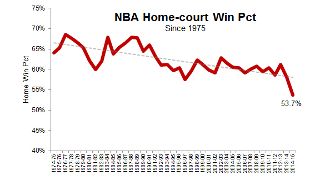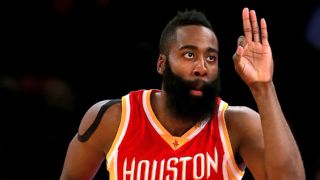|
Remember the Grizzlies-Spurs thriller in December? An instant classic, thick with big men hitting buzzer-beating 3s for each team, 3-point specialists coming up big at the best times and one improbable make after another. It took three overtimes before Memphis prevailed 117-116, creating an unusual scene: a mighty celebration of screaming and hugging Grizzlies, drinking in the victory not before 20,000 elated fans but in front of stunned and bewildered Spurs supporters heading home dejected. Because this game was in San Antonio. It's no secret that the home team wins most NBA games -- in no small part what the NBA regular season is for: to earn home-court advantage in the playoffs. Home court is valuable. Only, interestingly, it's not nearly as valuable as it once was. Earlier this month, our statistics guru Dr. Steve Ilardi alerted us to this bizarre trend and we've been tracking it ever since. That Memphis win wasn't a fluke. The hushed home crowd is becoming a thing this season. Home squads are losing all over the place -- including Tuesday night when they lost all six games. Take a look at the standings. By win-loss record, the Nets, Bulls, Mavericks, Pistons, Rockets, Heat, Bucks, Timberwolves, Magic and 76ers are all performing better on the road than at home. In fact, home teams have won only 53.7 percent of their games this season, the lowest such rate in modern NBA history. And it's not even close. Asked about the minimized home-court advantage, Rockets general manager Daryl Morey said he was on board with a fairer game that doesn't see inherent advantages for either side. "For the league, the closer the games, the better," Morey told ESPN.com in a phone interview. "More objective, the better." This effect is real. And it's changing the NBA as we know it:  • In 1976-77, the home team won a startling 68.5 percent of games. In 2002-03, it was 62.8 percent. Over the past four seasons, the home team's win percentage has fallen steadily from 61.2 to an all-time low of 53.7 right now. • In two years, home-court advantage has been sliced by nearly a third (28.5 percent), which represents the largest two-year drop in NBA history. From a points perspective, the home team has seen just a 2.2-point advantage this season. We've never seen it this small. Last season, it was plus-2.6. The season before that, plus-3.2. • This carried over into the postseason. Last playoffs, the home team went 50-39, pulling out the victory in 56.2 percent of the games. That's significantly lower than the historical playoff average that hovers around 65 percent. The home team enjoyed just a 2.8-point cushion last postseason, down from 4.0 in 2012-13 and 4.7 in 2011-12. As recently as 2007-08, the home playoff team enjoyed an 8.1-point edge and won 74.4 percent of all games. Adjusting for pace, the home-court advantage last season was just a third of what it was when the Celtics won the title in 2008 (plus-9.0 vs. plus-3.0). • This isn't just a midseason blip. Last season, home-court advantage was plus-2.3 through each team's first 50 games, about the same as it is now. It had never been lower than plus-2.6 in the last 15 seasons at this juncture in the season. • Most striking? In close games, home teams are losing more often than not. In clutch games, when the score is within five points in the final five minutes, the home team has won just 47.7 percent of the 354 games. Here's how crazy this is: Heading into the season, the average win percentage for the home team in clutch games since 1997 was 54.7 percent and never below 51.6 percent. Yes, it's the first time that the home team has not won more than half its close-and-late games. That Memphis game was the rule, not the exception. • Ten teams have a better record on the road than at home. In the four seasons between 1997-98 and 2000-01, there were no such teams. In fact, the 10 teams this season matches the same total that we've seen in the previous eight seasons combined. • This is unlikely to be random. The home-court advantage decline over the past two seasons is statistically significant, meaning that the math suggests there is a less than 5 percent chance, given the historical baseline of 3.5 points and 60 percent home win percentage, that this is anything other than a trend. The question: Why? What the heck is going on? The short answer: It's not clear. We'd like to hear your theories (see below). There likely isn't one driving factor that explains the eroding home-court advantage, but a combination of ingredients. After talking around the league, here are three leading theories:
Theory 1: The NBA is more 3-point heavy, less dependent on refereesYou may not have noticed, but the NBA has recently undergone a fundamental shift in play. For the first time in NBA history, there will be more 3-point attempts than free throw attempts this month. First time ever! The average NBA game sees 45 3-pointers compared to 44.7 freebies. Ten seasons ago, those figures were 32.1 and 53.2 in January, respectively. After much headway, teams have finally closed the gap.  Long shots from open players mean less contact, fewer fouls and, therefore, less chance for the humanity of referees to influence outcomes. Numerous studies have shown that referees may be involuntarily influenced by the home crowd. In their book "Scorecasting," Toby Moskowitz and Jon Wertheim found that injury time is longer when the home team stands to benefit from the extra delay. Another published study found that the referee bias is larger if there is no running track around the stadium to separate the officials from screaming home fans in close proximity. In baseball, the home plate umpire does give the home pitcher the benefit of the doubt on close pitches. The NBA league office, which declined to comment on the matter, has been overhauling officiating oversight in recent years. Under Adam Silver, a replay center has been established to review critical calls in the closing minutes at an off-site location. Furthermore, every whistled call is reviewed and graded "correct" or "incorrect" by the league office, and referees are given feedback on a regular basis. However, word is that there are no home-road splits in these detailed reports, so it's hard to connect those dots. It's possible that referee bias has changed the equation, but it's also true that sea-change 3-point strategy could be removing the referee from the equation altogether.
Theory No. 2: Technology has allowed teams to handle the road better"Teams are smarter about their travel habits and getting rest these days," Mark Cuban tells ESPN.com. "Guys aren't going out as often, so the road just isn't as hard as it used to be." A bunch of execs we spoke with brought this one up. Maybe the road isn't having the effect it once had on players' bodies, in part because of technology. By leveraging sport science and partnering with cutting-edge injury prevention companies, teams are trying to reduce the wear-and-tear on their players' bodies and raising awareness about recovery. Biometrics are invading the NBA. As we reported this summer, more and more players are treating their bodies like well-oiled machines. Another team executive suggests a key difference is the embrace of video scouting technologies like Synergy Sports Technology. Chris Paul, for instance, says he is "in Synergy all day, every day." With a press of a button, a scholarly big man can watch 500 pick-and-rolls by the upcoming point guard and analyze his most subtle tendencies. That simply wasn't possible even 10 years ago. Nowadays you may find a star player on the charter flight watching game film instead of playing Texas Hold 'em. In the days of VCRs and editing suites, only home teams had their full scouting powers. "Video technology," says one Eastern Conference general manager, "was an absolute game-changer." There's also a claim from an executive that the long-term decline of home-court advantage can be attributed to the league-wide shift from flying commercial to flying charter in the late 1980s and early 1990s. By all accounts of early NBA travel, flying coach was brutal. We're talking about the largest humans on the planet packed like 7-foot sardines for hours. Home teams won 67.9 percent of games in 1987-88, but that slowly fell to 57.5 percent by 1994-95 as charters became more popular. Though this wouldn't explain the recent downturn, it helps to explain the massive decline in the 1990s.
Theory 3: Home crowds are no longer the sixth manThis is the Bill Simmons proposal, which he laid out on the B.S. Report talking to Grantland's Zach Lowe, who has also noticed the same trend. Look at the home crowd at any point in a game and chances are you'll find plenty of people too busy glancing at their phones to care about the game. Facebook and the guy at the free throw line are battling for your attention, and many believe Facebook is winning.  It's plausible. Furthermore, the widespread growth of corporate boxes may make the games less populated by the most rabid fans. Compounding that effect is that the HD television experience has improved so dramatically that hard-core fans may rather stay home and watch League Pass instead of ponying up the cash to go to the game. Social media has a hand in this too. DVR and League Pass have allowed fans to Vine their own clips and share them across the world within seconds. Rather than cheering the latest dunk, they are switching the filters on it in Instagram. This brings us back full circle to accountability for referees. Make a bad call 15 years ago and you just hope it didn't make it onto "SportsCenter." Now, you hope your boss or your nephew or your neighbor isn't texting you video of it. It's not totally clear what is happening, but it's crystal clear that it matters. Home-court advantage isn't just one of the major points of the regular season. It's also often decisive in who wins the title. And it's going away. We'd love to hear your thoughts. Use the hashtag #HomeCourtDisadvantage and hit us up @ESPNNBA or @tomhaberstroh on Twitter.
|

